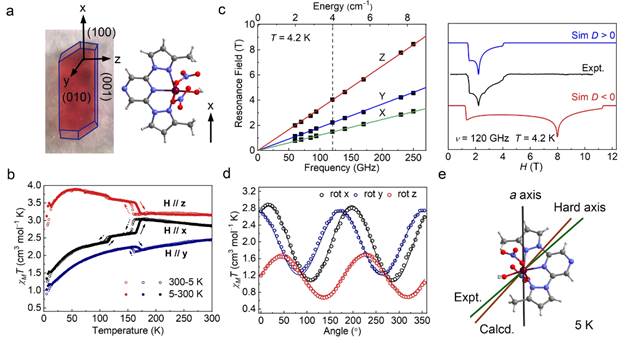
Determination of the magneto-crystalline anisotropy and its variations in a single crystal
Background
Water reorientation is essential in a wide range of chemical and biological processes. However, the effects of such reorientation through rotation around the metal–oxygen bond on the chemical and physical properties of the resulting complex are usually ignored. Most studies focus on the donor property of water as a recognized σ donor-type ligand rather than a participant in the π interaction. Although a theoretical approach to study water-rotation effects on the functionality of a complex has recently been conducted, it has not been experimentally demonstrated.
What did we discover?
In this study, we determine that the magnetic anisotropy of a Co(II) complex can be effectively controlled by the slight rotation of coordinating water ligands, which is achieved by a two-step structural phase transition. When the water molecule is rotated by 21.2 ± 0.2° around the Co–O bond, the directional magnetic susceptibility of the single crystal changes by approximately 30% along the a-axis due to the rotation of the magnetic anisotropy axis through the modification of the π interaction between cobalt(II) and the water ligand. The theoretical calculations further support the hypothesis that the reorientation of water molecules is a key factor contributing to the magnetic anisotropy transition of this complex.
Why is this important?
This study highlights that the reversible rotational reorientation of coordinated water in response to external stimuli, such as temperature, can be realized in crystals, and such subtle structural changes of the water ligand can have drastic effects on the magnetic anisotropy. Consequently, the orientation of coordinated water will be definitely considered when analyzing the performance of materials or devices in the presence of water molecules. We believe that the discovery of the effect of the orientation of water ligands will be useful for improving the physical properties of materials and for further promoting the application of functional complexes, especially molecular magnetic materials, in devices and the bioimaging.
Why did we need WHMFC?
To accurately determine the anisotropic parameters of the Co(II) center, a tunable-frequency high-frequency electron paramagnetic resonance (HF-EPR) spectroscopy experiment was performed on a polycrystalline powder sample of 1 at 4.2 K at frequencies between 60 GHz and 250 GHz. The full set of spin Hamiltonian parameters, includingD,E, and the values of theg-matrix, was obtained by least-squares fitting to the complete two-dimensional array of the resonances. The best fit was obtained with the parameters (S = 3/2): D = 32.01 cm−1, |E| = 4.30(2) cm−1, gx = gy = 2.45(2), and gz = 2.25(2). These results are in reasonable agreement with the parameters derived from the DC magnetic data. It is clear that the simulation using a positive D value is in good agreement with the experimental data. This result clearly indicates that this compound exhibits easy plane magnetic anisotropy.
Who did the research?
Sheng-Qun Su,1 Shu-Qi Wu,1 Masato Hagihala,2,3 Ping Miao,2,4,5 Zhijian Tan,2,4,5 Shuki Torii,2 Takashi Kamiyama,2 Tongtong Xiao,6 Zhenxing Wang,6 Zhongwen Ouyang,6 Yuji Miyazaki,7 Motohiro Nakano,7 Takumi Nakanishi,1 Jun-Qiu Li,1 Shinji Kanegawa,1 Osamu Sato1
1. Institute for Materials Chemistry and Engineering & Integrated Research Consortium on Chemical Sciences (IRCCS), Kyushu University, Fukuoka 819-0395, Japan.
2. Institute of Materials Structure Science, High Energy Accelerator Research Organization (KEK), Tokai, Ibaraki 319-1106, Japan.
3. Department of Materials Structure Science, Sokendai (The Graduate University for Advanced Studies), Tokai, Ibaraki 319-1106, Japan.
4. Institute of High Energy Physics, Chinese Academy of Sciences, Beijing 100049, China.
5. Spallation Neutron Source Science Center, Dongguan 523803, China.
6. Wuhan National High Magnetic Field Center & School of Physics, Huazhong University of Science and Technology, Wuhan 430074, China.
7. Research Center for Thermal and Entropic Science, Graduate School of Science, Osaka University, Toyonaka, Osaka 560-0043, Japan.
Acknowledgments
We thank Prof. Masaaki Ohba for his help in angular-resolved magnetometry studies, Prof. Kazunari Yoshizawa and Prof. Yoshihito Shiota for their help in theoretical calculations. This work was supported by JSPS KAKENHI Grant Number 18K14244 and 20H00385. This work was supported by the MEXT Project of “Integrated Research Consortium on Chemical Sciences”. The synchrotron radiation experiments were performed at the BL02B1 of SPring-8 with the approval of the Japan Synchrotron Radiation Research Institute (JASRI) (Proposal No.2018A1213). Neutron powder-diffraction were at BL08 located at the Spallation Neutron Source at the Japan Proton Accelerator Research Complex (J-PARC) (Proposal No.2019A0226). This work was partly supported by Nanotechnology Platform Program (Molecule and Material Synthesis) (JPMXP09S20MS1076) of the Ministry of Education, Culture, Sports, Science and Technology (MEXT), Japan.
Link
https://doi.org/10.1038/s41467-021-23057-4
